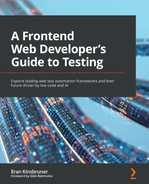Discover expert tips and best practices for maximizing the efficacy of various test automation frameworks and gain a better understanding of their capabilities for your web projects Testing web applications during a sprint poses a challenge for frontend web app developers, which can be overcome by harnessing the power of new, open source cross-browser test automation frameworks. This book will introduce you to a range of leading, powerful frameworks, such as Selenium, Cypress, Puppeteer, and Playwright, and serve as a guide to leveraging their test coverage capability. You'll learn essential concepts of web testing and get an overview of the different web automation frameworks in order to integrate them into your frontend development workflow. Throughout the book, you'll explore the unique features of top open source test automation frameworks, as well as their trade-offs, and learn how to set up each of them to create tests that don't break with changes in the app. By the end of this book, you'll not only be able to choose the framework that best suits your project needs but also create your initial JavaScript-based test automation suite. This will enable fast feedback upon code changes and increase test automation reliability. As the open source market for these frameworks evolves, this guide will help you to continuously validate your project needs and adapt to the changes. If you are a frontend developer working with popular frameworks, such as Vue or React, and want to develop testing skills by learning the essentials of test automation, this book is for you. An intermediate-level understanding of JavaScript and frontend development is assumed.Key Features
Book Description
What you will learn
Who this book is for
Table of Contents
- A Frontend Web Developer's Guide to Testing
- Contributors
- About the author
- About the reviewer
- Foreword
- Preface
- Part 1 – Frontend Web Testing Overview
- Chapter 1: Cross-Browser Testing Methodologies
- Chapter 2: Challenges Faced by Frontend Web Application Developers
- Chapter 3: Top Web Test Automation Frameworks
- Chapter 4: Matching Personas and Use Cases to Testing Frameworks
- Chapter 5: Introducing the Leading Frontend Web Development Frameworks
- Part 2 – Continuous Testing Strategy for Web Application Developers
- Chapter 6: Map the Pillars of a Dev Testing Strategy for Web Applications
- Chapter 7: Core Capabilities of the Leading JavaScript Test Automation Frameworks
- Chapter 8: Measuring Test Coverage of the Web Application
- Part 3 – Frontend JavaScript Web Test Automation Framework Guides
- Chapter 9: Working with the Selenium Framework
- Chapter 10: Working with the Cypress Framework
- Chapter 11: Working with the Playwright Framework
- Chapter 12: Working with the Puppeteer Framework
- Chapter 13: Complementing Code-Based Testing with Low-Code Test Automation
- Chapter 14: Wrapping Up
- Other Books You May Enjoy
